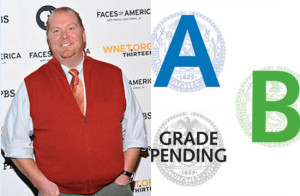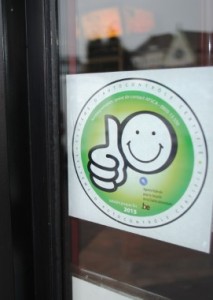People want some sort of grading system for the places where they spend their money on food.
There are lots of disclosure systems – A,B,C; red, yellow, green, numbers, web-based – and they can all be improved.
But in the absence of a credible system, someone will fill the vacuum,  often with quackery or scams.
often with quackery or scams.
As reported by the Sunday-Star Times in New Zealand, a company set up by a convicted identity thief and a banned company director is under investigation, after they teamed up in a “tick” scheme for hygiene standards that drew in hundreds of businesses nationwide.
The Companies Office is looking into the activities of the Hygiene Foundation – including investigating those at the top of its management structure – after complaints from former employees and clients. The company has denied any wrongdoing, with a representative maintaining that the company is above board.
However, a Sunday Star-Times investigation has uncovered that: One of those running the Hygiene Foundation is Lance Ryan, aka Lance Jared Thompson, who was convicted of stealing the names of five dead people to claim welfare payments in 2005. The other is alleged to be David Blake, aka David Colin Hughey, who is currently serving a five-year director’s ban after he was found to be running a company while an undischarged bankrupt. It is illegal to manage a business for three years while bankrupt.
The company falsely listed big-name clients such as Pizza Hut owners Restaurant Brands and Southern Cross Hospitals on its website It handed out certification to its “cleanliness” program to some parties without undertaking any hygiene tests, to build a client base.
The company failed to pay many of its staff, and has since been ordered to pay almost $200,000 in unpaid wages and compensation through the Employment Relations Authority. The Hygiene Foundation Ltd was set up in 2012 with Ryan as its owner. It has since passed through several pairs of hands and is now wholly owned by another of Ryan’s companies – the Investment Foundation – of which David Blake’s wife Hayley Blake is also a shareholder. It promoted itself as a cleanliness advisory firm, offering a “White Tick Program” to clients that recognised they had met certain hygiene criteria via tests carried out by its technicians, potentially achieving the standards with equipment lent by the foundation itself. Companies could display the tick once certified.
However, former employees say the certificates were often handed out without any testing and the scheme was essentially a scam. Sharon Zer, who was hired as a regional manager on a salary of $78,000, said she and her colleagues were told to sign up customers for free in order to  gain membership numbers before their hygiene testing equipment had even arrived. Companies were listed as members and got certificates, but never had the swab or air testing promised – essentially getting a “tick” for nothing. “
gain membership numbers before their hygiene testing equipment had even arrived. Companies were listed as members and got certificates, but never had the swab or air testing promised – essentially getting a “tick” for nothing. “
When the Sunday Star-Times visited the Foundation’s premises on Albert St, Auckland, its offices were empty and signs taken down. A man present at the address said he “had nothing to do with the company” and was just “using the space”. On Wednesday, David Blake said he was no longer involved with the company and was now working in “sales”. The next day, his phone line was disconnected. Lance Ryan’s phone was also disconnected by Thursday. However, he replied to an email denying the allegations in this story – saying the company had not acted illegally in any way. He denied that David Blake ever ran the Hygiene Foundation. “He worked for the company. He’s totally allowed to do that,” he said. Ryan said the White Tick system was completely above board. ” We spent in the tens of thousands of dollars on imported top-of-the-range equipment,” he said The company was no longer trading, he said. Its license had been sold to a third party and previous management “no longer had any say in the business”. Ryan said while he had “a past”, he had changed his name for a legitimate reason – both he and Blake were being blackmailed, he said. “If someone has a complaint about my actions as a director I encourage them to take it to the Companies’ Office or sue me directly. I did nothing wrong,” he said. “The Hygiene Foundation was not doing anything illegal.”
Here’s a more rigorous suggestion for disclosure in NZ.
Filion, K. and Powell, D.A. 2011. Designing a national restaurant inspection disclosure system for New Zealand. Journal of Food Protection 74(11): 1869-1874 .
The World Health Organization estimates that up to 30% of individuals in developed countries become ill from contaminated food or water each year, and up to 70% of these illnesses are estimated to be linked to food service facilities. The aim of restaurant inspections is to reduce foodborne outbreaks and enhance consumer confidence in food service. Inspection disclosure systems have been developed as tools for consumers and incentives for food service operators. Disclosure systems are common in developed countries but are inconsistently used, possibly because previous research has not determined the best format for disclosing inspection results. This study was conducted to develop a consistent, compelling, and trusted inspection disclosure system for New Zealand. Existing international and national disclosure systems were evaluated. Two cards, a letter grade (A, B, C, or F) and a gauge (speedometer style), were designed to represent a restaurant’s inspection result and were provided to 371 premises in six districts for 3 months. Operators (n = 269) and consumers (n = 991) were interviewed to determine which card design best communicated inspection results. Less than half of the consumers noticed cards before entering the premises; these data indicated that the letter attracted more initial attention (78%) than the gauge (45%). Fifty-eight percent (38) of the operators with the gauge preferred the letter; and 79% (47) of the operators with letter preferred the letter. Eighty-eight percent (133) of the consumers in gauge districts preferred the letter, and 72% (161) of those in letter districts preferring the letter. Based on these data, the letter method was recommended for a national disclosure system for New Zealand. http://www.ingentaconnect.com/content/iafp/jfp/2011/00000074/00000011/art00010
